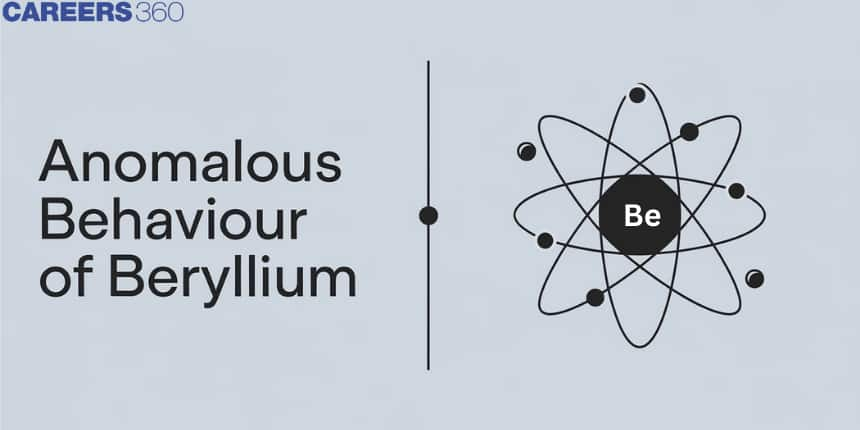Anomalous Behaviour of Beryllium
Imagine certain situations whereby you need your material strong, yet light, corrosive-resistant, and resistant to high temperatures. Obviously, at no time is such material coming at a free cost into being. This material, beryllium, very vital in the engineering industry, like aerospace, where every gram counts, and the electronics industry because it deals with durability. Although beryllium, due to its position within Group 2 of the Periodic Table, is an alkaline earth metal by definition, some of its properties may differ appreciably from those of other family members in the same column, that is, magnesium and calcium. Deviation from this type of behavior is called anomalous behavior.
NEET 2025: Mock Test Series | Syllabus | High Scoring Topics | PYQs
JEE Main: Study Materials | High Scoring Topics | Preparation Guide
JEE Main: Syllabus | Sample Papers | Mock Tests | PYQs
- Properties of Beryllium
- Understanding the Anomalous Behavior of Beryllium
- Some Solved Examples

Berylium differs from the rest of the alkaline earth metals on account of its small atomic size, high electronegativity, and a slight difference in electronic configuration. Be2+ is very small. It exerts a high polarising effect on any anion associated with it. On account of this, beryllium compounds show a covalent character. Its compounds have low melting points and are soluble in organic solvents. These are hydrolyzed in water.
Properties of Beryllium
- It is the hardest of all alkaline earth metals.
- The melting and boiling points of the beryllium are the highest.
- It is not affected by the atmosphere.
- It does not decompose water.
- It has the tendency to form covalent compounds
- It does not react directly with hydrogen.
- It dissolves in alkalies with the evolution of hydrogen.
- It does not liberate hydrogen from acids readily.
- Its oxide is amphoteric in nature.
- Its hydroxide is amphoteric in nature.
- Its carbide on hydrolysis evolves methane.
- Its carbonate is not stable towards heat.
- Its sulphate is soluble in water.
- BeCl2 is a covalent compound.
- It has a strong tendency to form complex compounds.
- It has a tendency to form alloys.
Understanding the Anomalous Behavior of Beryllium
Beryllium, atomic number 4, is a member of the periodic table Group 2: the alkaline earth metals. Be, though belonging to this group in the Periodic Table, shows most of its properties to be very different from its congeners: magnesium, calcium, strontium, Ba, and radium, Ra.
The deviation arises due to:
- Relatively High Electronegativity
- Small atomic and ionic size
- High Ionization Energy
Characteristics and Examples of Anomalous Behavior of Beryllium
The bond cannot be ionic with equal sharing of electrons because it is impossible for beryllium due to its small size and high charge of. This turns out to be another striking feature of its anomalous behavior. While MgCl2 and CaCl2 can be the usual examples of ionic compounds, beryllium chloride itself is actually a covalent polymer. The covalency extends to its compounds with other elements too. Even the hydride of beryllium consists of structures that are polymeric rather than just mere simple ionic compounds.
The following are some of the key examples:
Beryllium Chloride, BeCl2: The chloride is a covalent polymeric structure rather than being an example of a simple ionic compound.
Beryllium Hydride, BeH2: The hydride also forms polymeric structures.
Beryllium Oxide, BeO: The oxide is amphoteric, and dissolves both in acids and bases to give beryllium salts and beryllates, respectively.
Importance and Uses in Various Fields of the Anomalous Property of Beryllium
Such anomalous behavior of beryllium plays a vital role both in academics and practical applications.
- This anomalous behavior of beryllium helps the academic chemist about how atomic size and ionization energy in atoms affect chemical bonding.
- Nuclear Reactors Used as neutron moderator and reflector.
- Draws the attention of the aerospace industry for aircraft and spacecraft parts since it is a light metal with high strength, and hence is an ideal metal to be used for their construction.
Recommended topic video on ( Anomalous Behaviour of Beryllium)
Some Solved Examples
Example 1: A metal M readily forms a soluble sulfate MSO₄ and has an oxide MO that becomes inert on heating. It also forms an insoluble hydroxide M(OH)₂ that is soluble in NaOH. What is the identity of metal M?
1) Be
2) Mg
3) B
4) Ar
Solution: The metal is Beryllium (Be). It forms BeSO₄, which is water-soluble, and its oxide BeO becomes inert upon heating.
Example 2: Which metal is used for making X-ray tube windows due to its transparency to X-rays?
1) Mg
2) Ne
3)Be
4) Na
Solution:The metal used is Beryllium (Be), as it is transparent to X-rays.
Example 3: How many atmospheric compounds are present among the following: BeO, BaO, Be(OH)₂, Sr(OH)₂?
1) 3
2) 4
3) 2
4) 1
Solution:There are 2 atmospheric compounds: BeO and Be(OH)₂. Both are amphoteric, unlike the other compounds listed.
Summary
Anomalous behavior like this aside, the general path of beryllium would be quite different from that of the other alkaline earth metals. It is these very small atomic size, high ionization energy, and peculiar bonding properties that come together to act in unison to give out the described unique properties. Beryllium varies a lot from the members of that group since it has apparently a different trend about resistance formation to the formation of the ionic bond, and also it has amphoteric oxides and hydroxides with high covalency in compounds
Also Read
19 Feb'25 10:44 AM
17 Dec'24 10:24 AM
17 Dec'24 10:21 AM
29 Nov'24 12:13 PM
30 Sep'24 02:31 PM
30 Sep'24 11:46 AM
26 Sep'24 06:10 PM
26 Sep'24 05:53 PM

